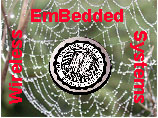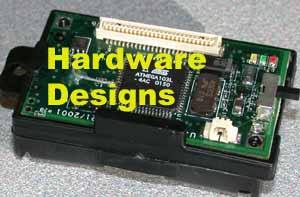|
|
Berkeley
WEBS
|
 |
TinyOS Site People
Presentations
Publications
DistributionLinks
Weekly Meetings In
the News
We are developing an Open Experimental software/hardware Platform for
Network Embedded Systems Technology research that will accelerate
the development of algorithms, services, and their composition into challenging
applications dramatically. Small, networked sensor/effector
nodes are developed to ground algorithmic work in the reality of working
with numerous, highly constrained devices.
Main elements of the platform consist of :
-
The hardware required for low-cost large-scale experimentation of Network
Embedded Systems,
-
The nodal OS that supports not just applications, but debugging, visualization,
communication, low-power consumption, and remote monitoring and control
,
-
The infrastructure services for time synchronization, storage, computing
and even large-scale simulations,
-
A powerful simulation environment that can effectively explore adversarial
situations and worst-case environments,
-
A debugging and visualization environment specifically geared toward large
numbers of interacting nodes, and support event-centric development
-
Mechanisms for composition of finite-state machines that enable modular
design, and
-
A macrocomputing language that simplifies programming whole collection
of nodes.
A series of challenges applications drive the use of the platform and middleware
services developed by NEST projects to realize fine-grain distributed control
techniques.
This platform will benefit the NEST community by allowing algorithmic
work to move from theory to practice at a very early stage, without each
group developing extensive infrastructure. Combined with these algorithmic
elements, the platform will permit demonstration of smart structures and
advance control. The framework of efficient modularity it provides will
accelerate reuse and sharing of common elements. The integrated use
of testbeds and simulation environment will allow algorithms to be deeply
tested. The execution elements of the platform implicitly define
the cost metrics for algorithmic analysis; which differ significantly from
traditional distributed computing. The programming model defines
mechanisms for adapting to changing environments.
Critical barriers are scale, concurrency, complexity, and uncertainty.
The nodal system must be of small physical scale, operate under constrained
power and bandwidth, support intensive concurrency, and extremely passive
vigilance. Thread-based models perform poorly in this regime, so
a FSM based approach is developed. Algorithms must utilize massive
numbers, rather than device power. A fundamental challenge is to understand
what an algorithm is doing in a reactive, diffuse network once deployed.
Testbed instrumentation and large-scale simulation attack the understanding
issue directly, even searching for Murphy's Law failures. Many of
the techniques used here have proven essential in scalable Internet services.
DARPA Project: Secure Language-Based Adaptive Platform for Network
Embedded Systems (Original
Proposal)
Project Meetings
Presentations
-
DARPA
NEST PI Meeting, Feb 5, 2002
-
Networks of Tiny Devices
embedded in the Physical World, Computing and Telecommunications Technology
Board meetings, 1/25/2002
-
EMSOFT 2001 Workshop on Embedded Software, A
Network-Centric Approach to Embedded Software for Tiny Devices, Oct
10
-
Intel MRL Systems Forum, Language
Challenges inspired by Networks of Tiny Devices, Oct 5
-
EECS Week: Network day panel: Ubiquitous
Networked Devices, Sept 17
-
EECS Week: Berkeley labs panel, Intel
Berkeley Extreme Interconnected Systems Lab, Sept 19
-
EECS Week: Visions and Impact, Extreme
Networked Systems: Large Self-Organized Networks of Tiny Wireless Sensors,
Sept 20
-
Wireless OEP
progress, DARPA NEST PI meeting, Sept 11, 2001
-
Convergence at the Extremes
- HPDC meets Tiny Networked Sensors, HPDC Invited Talk, Aug 2001
-
Endeavouring
to build Networks of Tiny Devices, June 2001 Endeavour/Citris Retreat
-
Emergence
of Extreme Networked Devices
USC Distinguished Lecture, Feb 28, 2001
-
Preview
at Jan 2001 Ninja retreat (Brewer, Culler)
-
Preretreat May 18, 2001
-
Nest Kickoff Meeting June 5, 2001
-
DARPA NEST PI meeting, Sept 11, 2001
Weekly talks
| Date |
Reading |
Agenda |
Documentation |
| 9/17/01 |
|
Phil Levis: TinyOS
Simulator, and latest documentation in PDF |
|
| 9/26/01 |
|
Jin Kim: Pursuit/Evasion
Games |
|
| 10/3/01 |
|
Sam Madden and Rob Szewczyk: Aggregation
in sensor networks, (pdf) |
|
| 10/10/01 |
|
Lance Doherty and Jason Hill: 29 Palms demo, theory
and practice |
|
| 10/17/01 |
|
TinyOS
programming bootcamp. Check out the new TinyOS
distribution |
|
| 10/24/01 |
|
Kamin Whitehouse, Localization in sensor networks |
|
| 10/31/01 |
|
David Wagner, Security & Adversarial simulations |
|
| 11/7/01 |
|
Luca Schenato, Bruno Sinopoli: Pursuit
Evation Games (PEGs) Using a Sensor Network |
|
| 11/14/01 |
|
No speaker, PEG testbed discussion |
|
| 11/21/01 |
|
Alec Woo, Sensor
board design review. The latest designs are here: schematic (
pdf,
OrCAD
DSN ) and layout. |
|
| 2/5/02 |
|
TinyOS 0.6 release and bootcamp. Check them out here |
|
| 2/12/02 |
|
Bruno Sinopoli, Distributed
Pursuit Evasion Games, the talk from the NEST PI meeting |
|
| 2/20/02 |
|
Semester Planning |
notes |
| 2/27/02 |
|
Kamin Whitehouse - Interactive
sensor web development environment |
notes,
talk slides |
| 3/6/02 |
|
No meeting |
|
| 3/13/02 |
SPAN,
GAF |
Chris Karlof |
|
| 3/20/02 |
Dominating
Set, |
Alec and Joe |
|
Publications
-
Jason Hill, Robert Szewczyk, Alec Woo, Seth Hollar, David Culler, Kristofer
Pister. System architecture directions for network sensors. ASPLOS
2000. (pdf)
-
Jason Hill, Philip Bounadonna, David Culler. Active Message Communication
for Tiny Network Sensors. (pdf).
-
Jason Hill. A Software Architecture Supporting Networked Sensors.
Masters thesis, December 2000.(pdf)
-
Alec Woo, David Culler. A Transmission Control Scheme for Media Access
in Sensor Networks. Mobicom 2001. (
pdf)
-
Adrian Perrig, Robert Szewczyk, Victor Wen, David Culler, J.D. Tygar. SPINS:
Security Protocols for Sensor Networks. Mobicom 2001. (pdf,
ps)
-
David E. Culler, Jason Hill, Philip Buonadonna, Robert Szewczyk, and Alec
Woo. A Network-Centric Approach to Embedded Software for Tiny Devices.
DARPA Workshop on Embedded Software.
-
E. Jason Riedy and Robert Szewczyk. Power and Control in Networked Sensors.(pdf)
-
Rachel Rubin. Analysis of Wireless Data Transmission Characteristics.(pdf)
In the news
Links



